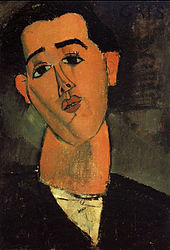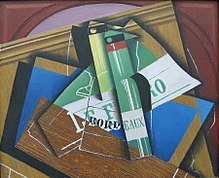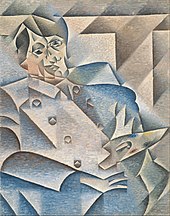Juan Gris

Juan Gris (born March 23, 1887 in Madrid , † May 11, 1927 in Boulogne-sur-Seine , France ; actually José Victoriano Carmelo Carlos González-Pérez ) was a Spanish painter .
Alongside Pablo Picasso and Georges Braque , he is the main representative of synthetic cubism . Gris mainly painted still lifes in which he placed picture elements next to and on top of each other as a collage . Gris incorporated the new design principles of Cubism into a rational system and throughout his work tried to convey his artistic approach theoretically.
life and work
Juan Gris, son of a wealthy businessman, was born José Victoriano González Pérez in Madrid on March 23, 1887 . He was the thirteenth of fourteen children. In the early years of his life, his uncle taught him the technique of painting. In 1902 he began his studies at the art school Escuela de Artes y Manufacturas in Madrid. In 1904 he finished his studies and began training as an artist with his close friend José Moreno Carbonero , who later became the teacher of Salvador Dalí . At this time he was already painting some pictures that were based on Art Nouveau . He earned his living with book illustrations for poems by José Santos Chocanos . He signed his works with the stage name "Juan Gris".
In 1906, at the age of 19, Gris left Spain and moved to Paris . There he kept himself afloat with caricatures for satirical magazines, two years later he moved to the Bateau-Lavoir . At that time, the studios of the Bateau-Lavoir were a gathering place for many young painters and writers. Gris met Pablo Picasso there ; stimulated by his studies, he turned to painting again.
From then on, Gris concentrated on analytical cubism . His first works were created in 1911, including houses in Paris that show the first cubist features. He had his first exhibition with 15 works at Clovis Sagot . In the same year, Gris became friends with the German art dealer Daniel-Henry Kahnweiler , who signed Gris and guaranteed him exhibition space for his works of art in museums and exhibitions. In 1912 Gris painted a portrait of Pablo Picasso.
In 1913, Gris' period of synthetic cubism began . His first synthetic works emerged from the examination of the work of Picasso and Braque. He incorporated elements such as newspaper, wallpaper and broken glass into his works. Following the example of Braques and Picasso, he made his first paper collés , an early form of the collage process . In 1914, during a stay in the south of France , Gris first met the painter, sculptor and graphic artist Henri Matisse , who greatly influenced and refined his painting technique. Since then, Gris has found his own visual language in which his expression seems to be consolidated. Amedeo Modigliani created a portrait of Gris in 1915.
Looking back at its beginnings, the theorist Gris said in his 1925 essay Chez les cubistes in the Bulletin de la Vie Artistique :
“Cubism? […] Today I am aware that cubism was nothing more than a new way of reproducing the world in the beginning […] I think that cubism was an analysis at the beginning that had nothing more to do with painting than the description of physical phenomena with physics. But now that all elements of the so-called cubist aesthetic are given a measure by the painting technique, [...] one can no longer accuse him of this. If what was called cubism was only a certain aspect, then cubism has disappeared; if it is an aesthetic , it has merged with painting. "
Gris began his architectural phase in 1916, when he placed more emphasis on shapes than colors in his paintings. When he met the French sculptor Jacques Lipchitz the following year , Gris began to paint sculptures in addition to painting. From the 1920s onwards, Gris' style became more poetic. He brought still lifes and landscapes together in one picture plane. For the outline design he now often used a wave shape, which is visible in his Pierrot and Harlequin depictions, for example . Gris now also frequently worked for the theater and created, among other things, costumes and decorations for Djagilev's Ballets Russes and for Charles Gounod's opera La Colombe . He was also a sought-after book illustrator.
In 1925, Juan Gris fell seriously ill and quickly deteriorated. On May 11, 1927, he died of urine poisoning in Paris at the age of forty . Some of his works were shown posthumously at documenta 1 (1955), documenta II (1959) and documenta III in 1964 in Kassel . Juan Gris was in the Paris Masonic Lodge Voltaire into the waistband of the Masonic added.
Works (selection)

- Houses in Paris (Solomon R. Guggenheim Museum, New York), 1911
- Still life with a carafe (private property of Dr. Speiser, Basel), 1912
- Still Life with a Guitar (Metropolitan Museum of Art, New York), 1913
- The Smoker (Thyssen-Bornemisza Museum, Madrid), 1913
- Violin and chessboard , (private collection), 1913
- The tea cups (K20-Kunstsammlung Nordrhein-Westfalen, Düsseldorf), 1914
- The Breakfast (Musée national d'art moderne, Center Pompidou, Paris), 1915
- Guitar, book and newspaper (Public Art Collection, Basel), 1920
literature
- Juan Gris - Life and Work, Daniel-Henry Kahnweiler. Hatje, Stuttgart 1968.
- Assouline, Pierre: The man who sold Picasso - Daniel-Henry Kahnweiler and his artists. Gustav Lübbe Verlag, Bergisch Gladbach 1990, ISBN 3-7857-0579-4 .
- The 100 of the century - painters. Edited by Jordan / Lenz. Rowohlt, Reinbek 1995, ISBN 3-499-16456-6 .
Web links
- Literature by and about Juan Gris in the catalog of the German National Library
- Materials by and about Juan Gris in the documenta archive
- Works by Juan Gris at Zeno.org .
- Juan Gris at the Paris Web Museum
- Juan Gris at The Athenaeum 164 works
Individual evidence
- ^ A b Anne Gantführer-Trier: Cubism. 2007, p. 56
- ↑ Juan Gris , artchive.com, accessed September 4, 2013.
| personal data | |
|---|---|
| SURNAME | Gris, Juan |
| ALTERNATIVE NAMES | González-Pérez, José Victoriano Carmelo Carlos (real name) |
| BRIEF DESCRIPTION | Spanish-French cubist painter |
| DATE OF BIRTH | March 23, 1887 |
| PLACE OF BIRTH | Madrid |
| DATE OF DEATH | May 11, 1927 |
| Place of death | Boulogne-sur-Seine , France |


